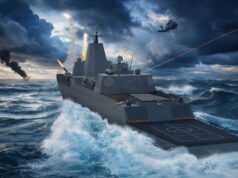Formidable Shield brought together eight NATO countries in the Outer Hebrides to test integrated air and missile defence capabilities through a series of live missile firings and demonstrations.
Rear Admiral Paul Bennett, Assistant Chief in Naval Staff Capability, Royal Navy, said:
“Formidable Shield 2017 marks a step change from an exercise we did two years ago, At Sea Demonstration 2015. We’ve got more credible targets, a more complex maritime task group and we are stepping up to ensure that we’re able to test our NATO task groups to the Nth degree.”
The Rt Hon Earl Howe, UK Minister of State for Defence, said when he visited the exercise:
“The UK MOD’s Hebrides range, managed by QinetiQ, is one of the most advanced of its kind for test and evaluation and essential for these complex and important exercises. MOD and QinetiQ investment of £60 million will ensure that it remains one of the most up-to-date facilities in the world, not just for test and evaluation, but for training and rehearsal as well.”
Captain Jonathan Lipps, Deputy Commander for Task Force 64, US Navy 6th Fleet, said:
“The range here provides a great opportunity to integrate the forces of the alliance, the members of the task force, the water space and the air space that we need to execute this fight. It’s of vital importance. There are few places in the world that we can conduct this type of operation. Here we can do it safely and capture the lessons learned that we need to build for the future.”
Steve Fitz-Gerald, Managing Director Maritime, Land and Weapons, QinetiQ said:
“Being able to undertake such complex and important exercises is vital for the UK’s future defence capability. In the MOD Hebrides Range, we have a truly world-class capability on our door step that is attractive to international customers and Formidable Shield demonstrates what the facility is capable of. QinetiQ will continue to make improvements and upgrade facilities as we look to meet our strategy of modernising UK test and evaluation.”














Would be handy if we “Stepped up” though Rear Admiral to be able to fire ABM missiles ourselves.
We already have the ships and the radar.
Not only would a land based solution be ridiculously expensive given MoD and HMG’s track record but it would set off the wailing from various CND types that such facilities make us more of a target.
Step change in system and requirement (including funding) would need to be articulated.
What BM threat does HMG believe we are exposed to and is it enough to fund?
North Korea alone should be enough to keep us up at night with ‘Rocket Man’ in charge!
It’s not just rocket man that we should keep an eye on, but also the mad mullahs and their surrogates. Iran is developing its medium range ballistic missiles, but thankfully haven’t the nuke capability and won’t last long if they do as Israel won’t allow the risk. Even in Yemen, where they’ve converted SA-5s to ballistic missiles. I’m pretty certain with Iranian assistance as they seem to be a lot more reliable and accurate.
The threat from Ballistic missiles has actually increased and we are now in the range of some of these weapons. It has been shown that North Korea is steadily increasing the range of their Hwasong-12. These can now definitely reach Guam from North Korea which is a distance of 4500 miles, which if aimed west is central Ukraine.
It has been proven that the T45s can successfully track ballistic missiles, and obviously the existing Aster 30 performance against these is justifiably kept secret. I’m sure the Navy will be buying a number of the ballistic missile capable Astor 30s, but only having 6 ships is not good enough to defend the country and carry out their primary duty of fleet protection.
Will it really cost the earth to develop a land based version of the system fitted to the T45s. isn’t there part of the system already in use, minus the missiles being used as a training and development asset by the Navy?
Oops my bad, their Hwasong-14s have an estimated range of 10000miles. This places the majority of Europe including the UK firmly within its range, if fired Westerly and in to the central American belt states of the US if fired Easterly.
Food for thought!
Hi Dave
May be it wouldn’t.
My comment above concerned starting a new fixed site, associated radar, planning permission, local objections, and all the rest whenever the MOD tries to do anything. Just look at the fuss over Watchkeeper training.
Although as you rightly say an extra Sampson and 1850M radar are on Portsdown Hill at the MWC and Land Based Test Site, maybe these could be used??
Who says they are not? However the U.K. ceased landed based medium altitude and above SAM when Bloodhound was decommissioned.
Where would you put the new one(s). What would you use?
It would be simple to integrate into UKAD.
Where would the money come from?
What service would own it?
What would that service be willing to sacrifice etc.